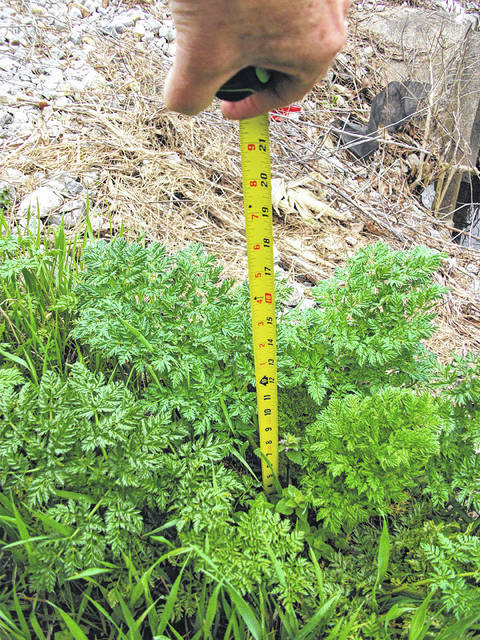
Editor’s note: This is the second part in a two part column on Home & Farm. The first part ran in the April 21 edition.
This biennial weed is growing rapidly now and will be soon exhibiting the white flower head to spread next year’s seed. On April 18 I measured plants 12-15 inches in height (see picture). By May 1 they probably will be over 36 inches tall. A full grown plant poison hemlock plant can reach the 6-8 foot range.
The problems with the weed are many as it is poisonous to animals which eat it (horses, sheep, cattle etc.) and can cause an allergic reaction to people who come in contact with it. The plant resembles Queen Ann’s Lace or White Top and is a biennial in that the plant lives for two years and flowers the second year. It is common in some pasture fields; along fence rows and along streams or creeks.
For many people June is the time of year that this most prolific poisonous weed poison hemlock makes its appearance known through sight and smell even though it has been growing since last fall. Poison Hemlock (scientific name is Conium maculatum L.) is in full bloom by mid- June.
Once you see it and smell the flower one can drive down many roads and know it is present by the smell alone. It has a white flower and can grow to a height of 6-8 feet or more. The stalk has characteristic purple blotches; is hollow between the nodes and the leaves have a feathery appearance.
The plant resembles Wild Carrot or Queen Ann’s Lace on steroids. This weed can cause death in animals if they eat enough of it. Luckily it is usually the last plant eaten after other plants have dried up. Once eaten by the animal poison hemlock can cause respiratory failure. For a better picture of this weed log on to: www.youtube.com/watch?v=0btqxLjI5TA. This website takes you to a University of Wisconsin video on the weed.
Poison Hemlock is a biennial weed best controlled in the spring and fall. Fall treatments are more effective when they contain glyphosate and 2,4-D. Control of poison hemlock needs to occur while the plant is in the vegetative rosette state, so early spring is a good time to control second year plants and fall a good time to control first year plants. Recommended herbicides include 2-4-D, dicamba (Banvel/Clarity), Crossbow (2-4-D plus triclopyr), Remedy Ultra (triclopyr) and glyphosate. Since all of these products are designed to kill broadleaf weeds you may have damage to pasture plants like clover, or alfalfa.
The Remedy Ultra and Crossbow are the most expensive of these products but according to the Extension “2018 Ohio, Indiana and Illinois Weed Control Guide” BL. 789 they do the best job of controlling this weed. Always follow label instructions on all weed killers. Sadly at the time of year when the plant is flowering and in its second year of growth the only control measure is to mow it and if you only have a few plants destroy the seed heads. The plant will die after flowering but can spread hundreds of seeds for the next generation. Can you do your part to help control this weed on your property?
Few things are definite
In last month’s column I mentioned the possibility of keying the application of crabgrass control products to the blooming of forsythia or ornamental pears. Mother Nature is not cooperating this year. Both plants have been seen in flowering stage a few weeks ago but crabgrass is not germinating yet.
In looking at the Michigan State Growing Degree Tracker at: www.gddtracker.net/ and inputting the Xenia zip code you will find we have accumulated 100 GDD (Growing Degree Days) with 50 degrees F. as the base temperature as of April 18.
In 2017 we had accumulated 259 GDD and were well into the germination stage of crabgrass. The bottom line is we still have time to apply pre-emergent crabgrass control products.
The optimum time to apply these products is to make the application enough in advance of the germination to allow for the materials to be watered in and have time to work down to the 2-3 inch depth to control the crabgrass seed growth.


